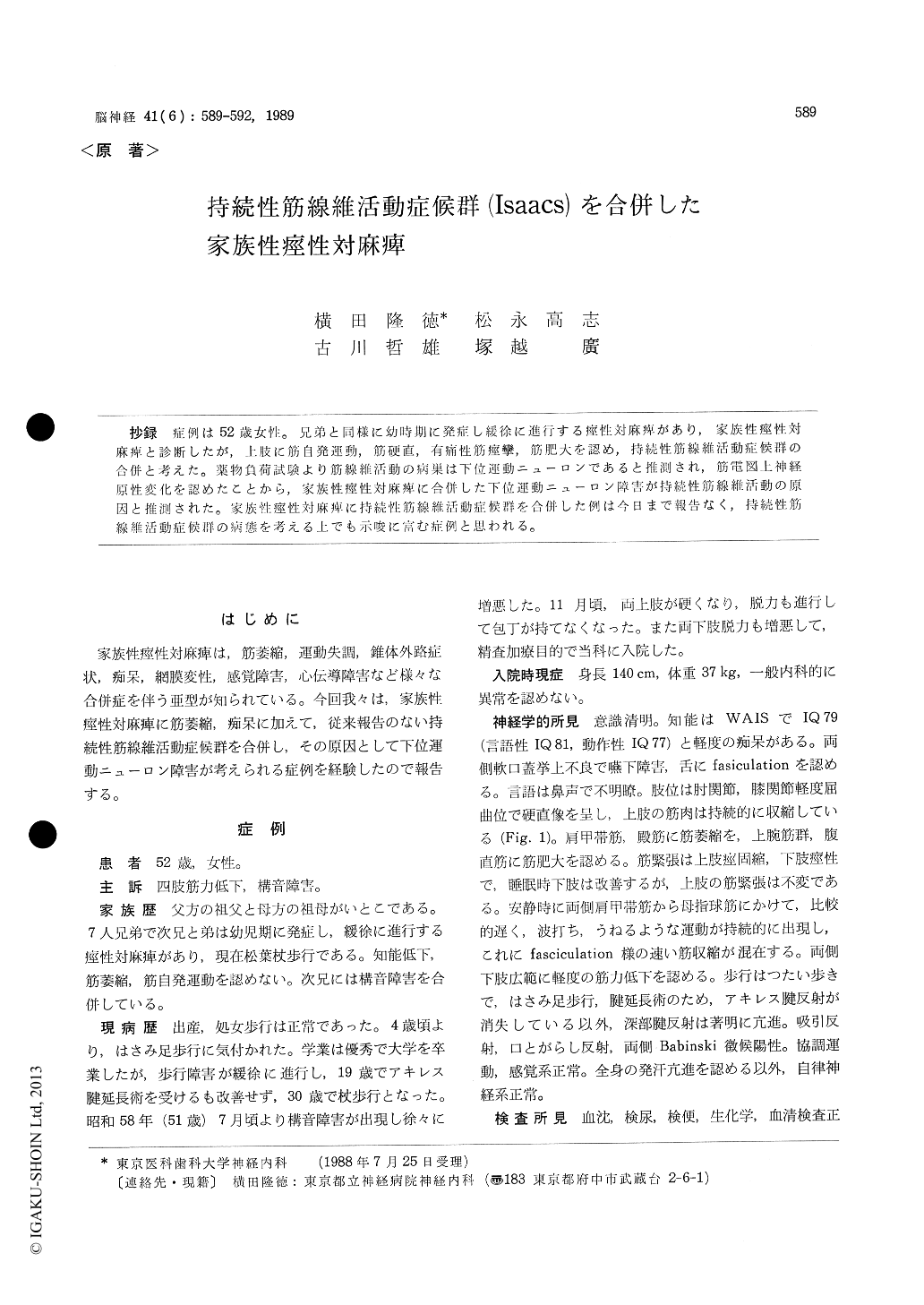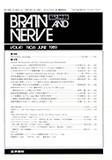Japanese
English
- 有料閲覧
- Abstract 文献概要
- 1ページ目 Look Inside
抄録 症例は52歳女性。兄弟と同様に幼時期に発症し緩徐に進行する痙性対麻痺があり,家族性痙性対麻痺と診断したが,上肢に筋自発運動,筋硬直,有痛性筋痙攣,筋肥大を認め,持続性筋線維活動症候群の合併と考えた。薬物負荷試験より筋線維活動の病巣は下位運動ニューロンであると推測され,筋電図上神経原性変化を認めたことから,家族性痙性対麻痺に合併した下位運動ニューロン障害が持続性筋線維活動の原因と推測された。家族性痙性対麻痺に持続性筋線維活動症候群を合併した例は今日まで報告なく,持続性筋線維活動症候群の病態を考える上でも示唆に富む症例と思われる。
A woman aged fifty-three developed paraparesis at the age of 4, which progressed slowly and required crutches by the age of 30. At the age of 51, muscle stiffness involved bilateral hands and arms gradually. At the age of 53, she suf-fered from painful spasms in right deltoid muscle. Her two brothers had spastic paraplegia without other neurological deficits. Her paternal grand-father and maternal grandmother were cousins.
Slight dementia was noted (WAIS : IQ, 79). Her posture was stiff and muscles of upper limbs were in a persistent contraction ; Subcutaneous tissue was thin, and muscles were well-defined and firm. There was moderate muscle weakness of legs and hands. Continuous fasciculations and myokymias were recognized in muscles of the arms and the limb girdles. Muscle tone was considerably in-creased especially in the bilateral arms. The deep tendon reflexes were exaggerated with extensor plantar responses. Profuse sweating affected palms, soles and backs. No sensory disturbance was ap-preciated. There was no myotonic responses to percussion of muscles.
Following laboratory data were normal ; thyroid functions, CSF studies, anti HTLV- I antibody and long chain fatty acid in red blood cells, myelography and brain CT except for increasedbasal metabolic rate (53%).
Electromyographic study in the arms and hands revealed spontaneous motor unit activities includ-ing doublets at rest and increased proportion of polyphasic-potentials and high amplitude poten-tials in voluntary contraction. Biopsy of right quadriceps femoris muscle showed hypertrophy of type I fibers and angulated atrophy of typeII fibers. Continuous muscle activities in upper limbs did not change at sleep or with intravenous administration of 7 mg diazepam. Neuro-muscular block with intravenous 10 mg curare injection abolished the discharges.
Syndrome of continuous muscle fiber activity (CMFA) has been considered as one of the disease in which alpha-motoneurons are in a hyperactive state. Our case had all characteristic clinical fea-tures of CMFA ; fasciculation, myokymia, muscle stiffness and painful spasms. The spontaneous muscle activity which persisted during sleep and disappered by curare was considered to originate from lower motoneuron.
Familial spastic paraplegia (FSP) are known to be associated with various neurological complica-tions including the disturbance of lower motoneu-ron. However, this is the first report in which FSP is associated with syndrome of CMFA. It is suspected that lower motoneuron involvement in FSP might be the cause of syndrome of CMFA.

Copyright © 1989, Igaku-Shoin Ltd. All rights reserved.


